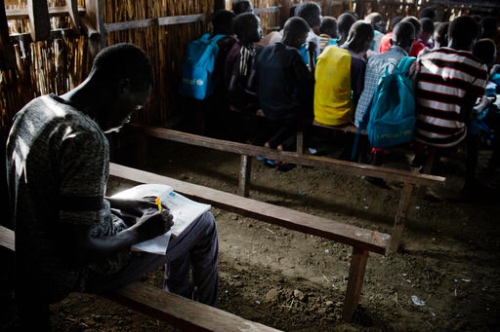Nairobi, Kenya
Thomson Reuters Foundation
A new app launched in South Sudan on Friday aims to help aid workers reunite thousands of children with their families after they became separated during a five-year war and identify other vulnerable children.
The app was developed by the United Nations children’s agency, UNICEF, and the charity Save the Children to allow the hundreds of field workers tracing families in South Sudan to share information on their phones or tablets.

James, a former child soldier who was shot through the leg while fighting and left for dead by his colleagues, completes his school work in a Protection of Civilian camp in South Sudan, on 25th September, 2018. James was separated from his mother, a widow, and his six sisters when he was abducted by soldiers while fishing with friends and forced to train to be a soldier. It was three years before he was reunited with her through a UNICEF programme. PICTURE: UNICEF/Kate Holt.
“Case workers are the backbone of everything we do. They walk for hours and hours under the scorching sun, wade through mud, travel for days on bumpy dirt roads to knock on doors,” said Rama Hansraj, head of Save the Children in South Sudan.
“They are in every corner of South Sudan, yet until now have found it difficult to communicate with other case workers on the other side of the country. With this new app, we’re bringing their work into the 21st century.”
South Sudan, the world’s newest country, has been ravaged by civil war since 2013 after clashes erupted between troops loyal to President Salva Kiir and his former deputy Riek Machar.
The government signed a peace agreement with rebels in September, but the war has had a devastating impact. At least 50,000 people have been killed and one in three South Sudanese have been uprooted from their homes.
Children have borne the brunt of the violence, said aid workers, with more than 19,000 registered as missing, unaccompanied or separated from their families.
While more than 6,000 children have been reunited with their families, thousands are still living with temporary foster families or in care centres.
Many were abducted by armed factions to be used as child soldiers, informants or porters. Others were separated from their parents after an attack on their villages.
Some separated children are also migrants from poor families forced to look for work, or runaways who were facing physical or sexual abuse at home, said aid workers.
Child protection case workers – who come from various charities as well as the government – will now be able to directly input data on separated children into the app so that other field workers can easily access it.
The app is connected to a database featuring children’s pictures and biodata, as well as details on circumstances leading to separation and where their family used to live.
“The app will be vital in a poorly connected South Sudan. It can be synced before the case worker heads out and allows them to access the necessary files while in remote areas,” said Helene Sandbu Ryeng from UNICEF in South Sudan.
The app has photo and sound features, which is crucial – especially when parents and their children have been separated for years, which is often the case in South Sudan, added Ryeng.
It will also help identify minors who need help such as counselling for trauma.
Field workers will be able to input data on their apps, according a level of priority so that it can be quickly followed up by child protection teams based in their offices.






